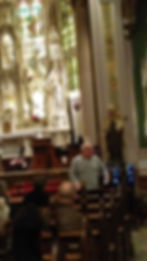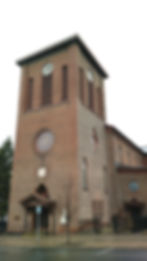Church Can Be Both Building and Mission
- Michael Lopez
- Mar 6, 2018
- 3 min read

Troy’s most prominent historic landmarks are storehouses of Tiffany windows. St. Paul’s Episcopal Church, Troy Public Library and Bush Memorial at Russell Sage College are nearly synonymous with Tiffany masterpieces.
It’s hard to imagine that more light can be shined on Tiffany, with its carefully catalogued pedigree and scholarship devoted to its design. But consideration about local Tiffany has been a bit muffled in the case of St. Joseph Roman Catholic Church at Third and Jackson streets in South Troy.
Built in 1848, the church holds 42 Tiffany windows of overwhelming beauty, bearing Tiffany’s trademark opalescence and heavily textured “drapery glass.” Well aware of this treasure, the congregation is considering their repair as part of an upcoming $400,000 capital campaign that will fund restoration of the wood window frames, a new heating and cooling system along with solar panels, masonry and roof repairs. The diocesan-wide campaign, “Re-igniting Our Faith,” will return 70 percent of the funds to local parish for bricks-and-mortar repair as well as to grow their congregations.
But St. Joseph also is positioning itself to have a greater public profile and access other grant dollars. In January, the church applied for a Sacred Sites grant offered by the New York Landmarks Conservancy, which required proof that the church is eligible to be listed on the National Register of Historic Places. Eventual listing would allow St. Joseph to target more grants requiring listing, including historic preservation funds through the NYS Consolidated Funding application.
Known as the “Iron Workers Church,” St. Joseph, one of several early Roman Catholic churches in Troy, was built by and for Irish residents who emigrated here to labor in the nearby iron mills largely established by Henry Burden, whose industry famously produced horseshoes at lightning speed. As Troy’s iron industry began to decline, Irish women in particular found employment as laundresses and assembly line workers in mammoth collar and cuff factories, which came into prominence as the shirt-making process became more and more automated in the late 19th century. Workers from Burden’s Iron and Nail Factory excavated for the church’s foundation in May 1847. On Nov. 1, 1848, the Rev. Peter Havermans – the missionary priest who established Troy’s earliest Catholic churches -- celebrated the first Mass in the unfinished church.
By raising their profiles and broadening their fund-raising beyond their walls, congregations can at once care for their buildings while fulfilling their ministries.
TAP’s message about the preservation of houses of worship has been consistent: their stewardship is the whole community’s responsibility if we value their architecture and artistry. But if historic preservation does not serve as enough of reason to hope that urban congregations thrive, the other stark reminder is that houses of worship act as de facto community centers for those in need. As important as the architecture and ornamentation is St. Joseph’s social action. Last year, the church served nearly 30,000 meals, provided for several thousand people who came to its food pantry and served Thanksgiving dinner to 113 people.

About 40-50 people visited St. Joseph Church in South Troy Sunday, March 11, to take in the sanctuary’s opulent beauty and in particular the 42 Tiffany windows. Thanks to the congregation and especially Paul Coffey for hosting Sudden Services, a program of TAP, Inc. and Historic Albany Foundation, which are staging social media flash mobs to invite the larger public in to witness the priceless architecture of area houses of worship. Stay tuned for upcoming events. The project has been funded in part by a grant from the John E. Streb Fund for New York of the National Trust for Historic Preservation.

Some Tiffany Photographs, Courtesy of Ned Pratt






Learn more about each window in this global survey HERE

















